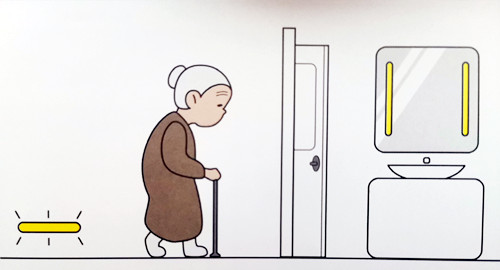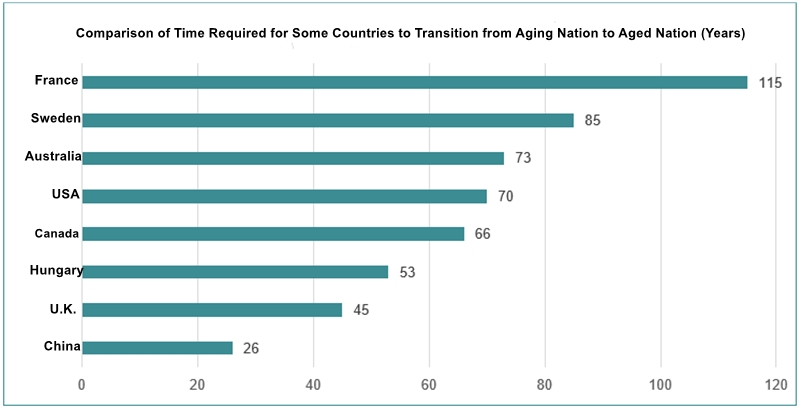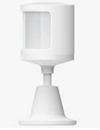- 11
- Aug
A Comprehensive Handbook for Optimal Smart Lighting Design for Seniors and the Elderly
A Comprehensive Handbook for Optimal Smart Lighting Design for Seniors and the Elderly
What defines an ideal retirement environment? Beyond financial and medical security, a wholesome, comfortable, and convenient home setting plays a pivotal role. China is grappling with a significant challenge in the 21st century – a rapidly aging population. The diminishing visual acuity and heightened psychological sensitivity among the elderly underscore their distinct requirements for the lighting environment. As advancements in products, systems, and design continue, intelligent lighting is emerging, blending software and hardware to infuse a human touch into illumination. Consequently, intelligent lighting tailored for the elderly holds the promise of effectively addressing their home lighting needs, fostering a serene and comfortable atmosphere for them (see Figure 1).

1. Effects of the Light Environment on the Elderly
1.1 Diminished Light Sensitivity and Increased Glare Sensation
The elderly experience a reduced sensitivity to light and heightened susceptibility to glare due to the decline in retinal function, lens rigidity, and pupil constriction. This results in a decrease in the amount of light entering the eye and a gradual weakening of light perception. Consequently, optimal vision for the elderly is achieved in brighter environments. However, excessively bright ambient lighting can amplify the discomfort of glare, subsequently weakening the eyes’ recovery mechanism following glare exposure. Furthermore, when exposed to light of high color temperature at the same brightness level, the elderly exhibit heightened sensitivity compared to young individuals, often experiencing a more intense sense of dazzling. As a result, environments with both high brightness and high color temperature can significantly impact the visual well-being of the elderly (see Figure 2).

1.2 Escalating “Night Blindness” and Diminished Light Sensitivity
With advancing age, a notable increase in “night blindness” becomes apparent, accompanied by a decline in light sensitivity. This phenomenon is closely tied to the gradual yellowing of the elderly’s cornea and lens. This discoloration impairs the brain’s ability to recognize blue and green light, resulting in the emergence of “night blindness.” Consequently, the elderly experience more pronounced vision deterioration during nighttime conditions(see Figure 3).

Furthermore, exposure to bluish light can heighten the risk of macular degeneration in the elderly’s eyes. Environments characterized by stark contrasts between light and darkness or excessively vivid color lights can disrupt the elderly’s light-sensing capabilities. This disruption, in turn, influences their perception of the surrounding environment and their ability to make accurate judgments.
1. 3 Diminished Contrast Sensitivity and Challenges in Target-Boundary Differentiation
As individuals age, their contrast sensitivity diminishes gradually. Consequently, the differentiation between objects and their backgrounds necessitates clearer demarcations and more pronounced contrasts.
Furthermore, as depicted in Figure 4, elderly individuals often adopt a hunched posture while reading books or newspapers. This stance leads to a lower line of sight and a narrower field of vision compared to younger individuals. To aid the elderly in effectively discerning boundaries in their surroundings, meticulous attention must be devoted to lighting design, particularly in crucial areas like the elderly’s high-frequency movement pathways, interior wall corners, and locations prone to slipping.

2 Principles of Home Lighting Design for the Elderly
2.1 Balancing Indoor Illumination for Uniform Brightness
In comparison to younger and middle-aged individuals, the elderly require higher illuminance in their living environment, as indicated in Table 4.5. Additionally, the elderly exhibit limited adaptability when transitioning between varying levels of brightness—moving from a well-lit to a darker space or vice versa. Thus, it’s crucial to avert abrupt shifts in illumination within the lighting design. The recommended ratio of local illuminance to overall illuminance is 10:1 at maximum, with an optimal control range of 3:1. This practice prevents a decline in individuals’ capacity to adjust to varying light levels due to diminished brightness uniformity.
4.5 Illumination Standards for the Living Environment of the Elderly
|
Comparison of illuminance in each area (standard value: recommended value for the elderly) |
Area | Illumination standard value (lx) |
Recommended value for the elderly (lx) |
|
Traffic area (1:3) |
hallway, stairs | 100-150 |
300-450 |
|
General area (1:1.5) |
general activity area | 100-200 | 150-300 |
|
restaurant, kitchen |
150-500 |
200-750 |
|
| bathroom | 100-200 |
150-300 |
|
|
Local area (1:2) |
write | 200-350 | 400-750 |
|
bedside reading |
150-200 |
300-400 |
|
| fine work | 250-500 |
500-1000 |
2.2 Opt for High Color Rendering Index and Anti-Glare Luminaires
The elderly often experience reduced ability to perceive color variations, as well as a diminished capacity to differentiate between hues that are closely related, such as red and orange, or blue and green. Selecting light sources with higher color rendering indices supports accurate identification of indoor colors by the elderly. Simultaneously, careful consideration should be given to employing multi-light source setups, which not only enhance overall brightness but also promote uniformity in illumination. Utilizing an excessively bright single lamp for lighting is ill-advised.
Moreover, the importance of opting for high-quality anti-glare luminaires cannot be overstated. It’s essential to ensure these luminaires are effectively shaded, preventing direct exposure to the human eyes. This precaution serves to minimize discomfort and potential eye strain.
2.3 High-frequency pathways and areas equipped with touch lamps for elderly
The elderly often contend with limited mobility, particularly during nighttime activities. To facilitate safer nocturnal movement, incorporating additional lighting as guideposts is essential. Especially when caring for the elderly during nighttime hours (refer to Figure 5), it’s advisable to install lighting sources approximately 0.4 meters above the ground along pathways connecting the bedroom, bathroom, and other frequently traversed areas. This strategic installation enhances both convenience and safety for nighttime navigation.

- Built-in magnetic tiles, can be attached to metal surfaces such as refrigerator lights.
- Backed with 3M adhesive stickers, easily adheres to the placement surface.
- Back-mounted hook, suitable for hanging in various scenarios such as wardrobes.
When selecting lighting fixtures, wireless night lights equipped with built-in human-body infrared sensors and photosensitive sensors are recommended. These fixtures are capable of monitoring human movement within the environment and automatically illuminating the area for the elderly. Additionally, considering the various scenarios in which the elderly might utilize nightlights—such as locating medicines—the selection should encompass nightlights with versatile installation methods. For instance, the nightlight featured in Figure 5 offers three installation options: magnetic attachment, adhesive backing, and hanging.
2.4 Implement Multi-Point Control Aligned with Elderly Living Patterns
Elevating the quality of life for the elderly through smart home solutions hinges on accommodating their existing routines. This is best achieved through efficient, uncomplicated, and dependable control methods. Control switches should be strategically placed in conspicuous locations, aligning with the elderly’s daily habits. Optimal positions include near the entrance and beside the bed. Moreover, within the primary activity zones of the elderly, consider augmenting the number of wireless switches. However, these controls should be user-friendly and straightforward to prevent issues arising from mobility challenges or memory impairment, which might hinder accurate light manipulation.
To further cater to the elderly’s preferences, both smart switches and conventional switches can coexist. This approach respects the established usage patterns of the elderly and minimizes the additional cognitive load associated with learning new control methods.
3. Vital Smart Lighting Modes for Elderly Residences
Night Mode: Enhancing Accessibility and Safety for Nocturnal Activities
During the night, the elderly can conveniently activate the intelligent dimmer switch positioned near the bed’s headboard. Alternatively, the under-bed human body sensor can detect their movement and trigger the ceiling lamp’s “moonlight mode.” Subsequently, the night light beneath the bed illuminates, and the pathway towards the bathroom is softly illuminated as the individual approaches. Additionally, the night light in the vicinity of the medicine storage area remains on standby, ready to assist. Upon opening the bathroom door, the door’s magnetic sensor initiates the “moonlight mode.” Refer to Figure 6 for a depiction of the varying illumination levels across different areas during this sequence. This specialized “night mode” caters to the needs of the elderly.

Upon the elderly person’s return to the bedroom, the lights can be switched off using the dimmer switch by the bed’s head. After a predefined duration of inactivity, the human body sensor detects the absence of movement and triggers an automatic shutdown of all lights. Refer to Figure 7 for an illustration of the lighting effects and illuminance distribution in the bedroom and bathroom under distinct viewing angles during the night mode event.

Best light bulbs for elderly:
The color temperature of ceiling lights, wall lights, night lights, and bathroom heater lights is all 2700K.
The brightness of the ceiling lights, wall lights, night lights, and bathroom heater lights is set to 10%.
4. Creating an Exclusive Lighting Environment for the Elderly, Step by Step
Step 1: Illumination Point Design
When designing lighting points for the elderly’s bedroom, consider incorporating elements from the ‘sleep aid mode.’ A crucial consideration involves the installation of motion-sensing night lights along pathways used by the elderly during nighttime movements, as well as near medicine cabinets. These thoughtful touches provide the elderly with meticulous care.
Step 2: Procure Luminaires and Smart Linkage Devices
For instance, when crafting the lighting layout for a child’s room, utilize an intelligent dimmer switch positioned near the bed’s headboard to activate ceiling and wall lamps. Along the path leading to the bathroom, employ multiple motion-sensing night lights that illuminate upon detecting human activity. Upon opening the bathroom door, a magnetic sensor triggers the bathroom heater’s light. Throughout this process, specific lamps (refer to Table 4.6) and intelligent linkage devices (refer to Table 4.7) are utilized.
Table 4.6 “Night mode” lamps
|
Lamp Name |
Lamp Size (mm) | Power (W) | Color Temperature (K) | Beam Angle (°) | Quantity(PCS) |
Lamp Image |
|
Smart ceiling light |
960*640 | 90 | 2700-6500 | 120 | 1 |
|
|
Smart wall light |
40*120*50 | 8 | 2700-6500 | 60 |
2 |
|
|
Sensor night light |
84*84*36 | 0.25 | 2700-6500 | _ |
4 |
|
| Smart Bathroom Heat Lamp | 15(power source) | 2700-6500 | _ |
1 |
|
This is the most popular hexagonal smart wall light, which can also serve as a small night light. This video was recorded when we sent samples to our customers.
Table 4.7 “Night mode” smart linkage equipment.
|
Device Name |
Function | Basic Parameters |
Product Image |
|
Smart Wireless Dimmer Switch (Surface Mount Board) |
Smart Dimming | Wireless Connectivity: BLE 4.2, Battery Life: Up to two years with 50 uses per day, Standby Time: Three years. |
|
|
Door/Window Sensor |
Detects bathroom door opening, triggers bathroom heater light |
Response time: 15ms Wireless connectivity: Zigbee |
|
|
Motion Sensor |
Detects human activity presence |
Maximum Detection Range: 7m Wireless connectivity: Zigbee |
|
|
Smart Multi-Mode Network Light |
Bluetooth mesh integration, intelligent interconnection | Wireless Connectivity: Wi-Fi 2.4 GHz; Zigbee 3.0; Bluetooth 5.0 |
|
Step 3: Establish Lighting and Smart Linkage Rules
(1) Connect Devices to the Smart Home System
Integrate the lamps and intelligent linkage devices into the smart home system in accordance with the provided product usage instructions.
(2) Activate Night Light Induction Mode
For the night light listed in Table 4.6, switch the night light to the “Auto” setting. The sensing mode operates exclusively in low-light conditions. This night light boasts a wide sensing angle of 120° and covers distances of 5-7 meters from the front and 2-3 meters from the side.
(3) Configure Smart Linkage Rules for the Bathroom
During the night-to-morning period (from 18:00 to 7:00 the following day), upon detection of the bathroom door’s opening by the window sensor, the Yuba heater light will activate. Subsequently, if the human body sensor registers no movement within 20 minutes, the Yuba heater light will automatically turn off.
5. Why is lighting important for elderly?
As the world embraces an aging society, home-based care for the elderly has become a mainstream concept and living model(Figure 8 ). It enables the elderly to savor their golden years in a familiar environment, extending their capacity to retain control over their bodies and lives to the fullest extent possible. Nonetheless, with advancing age comes a range of challenges. For instance, heightened sensitivity to light impairs their ability to watch TV unless the lights are dimmed. Frequent nighttime awakenings pose the risk of falls, as locating switches in the dark proves cumbersome.

All these issues underscore the need for specialized lighting solutions in the living environments of the elderly. Consequently, lighting design plays a pivotal role in the decoration of homes for the elderly.
It is my aspiration that this article can aid everyone in enhancing the lighting environment for the elderly. Such improvements can contribute to the elderly’s enhanced comfort, safety, and well-being. Particularly within nursing home facilities, this can be a valuable criterion for evaluating the superior management of elderly care establishments.
I also hope that lighting dealers, lighting engineering firms, and even procurement managers in prominent supermarkets will delve deeper into this domain after perusing this article. This novel avenue offers a fresh perspective rather than competing within traditional spheres, presenting an opportunity to carve out greater profit margins.








